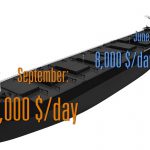What do you base your decisions on in times of uncertain market outlooks? Michael Payne, Managing Director of Maritime Strategies International (MSI), spoke to HANSA about the value of forecasts for the shipping sector
Mr. Payne, has the importance of consultancies and forecasts grown during the worldwide shipping crisis?
Michael Payne: The[ds_preview] weaker the market, the more uncertain the market, the greater the value of independent data driven advice. Where there is a restructuring opportunity, particularly when there is more than one party involved, the ability for us as recognized, credible providers of opinion as well as data gets more important because we typically will know most of the parties, whether it’s an intermediary, a bank or an accountant’s firm. We tend to be known by most of them and to get brought in to give advice. So, the greater the distress in the market, the greater the opportunity is for us. You could say, we trade on people’s misery, in a certain way.
Do shipping companies still make long-term decisions as they did in the past, based on this kind of advice?
Payne: Yes, the financing structures often require a forward view of cash flow and of value many years in the future. How they go about determining a cash flow forecast or a view of value years in a row that is a point of discussion. Some people take a long-term asset value approach, some take a discounted cash flow approach –there are many ways. We want to come up in this area from our own perspective that is driven by independent bottom-up sector by sector views where we take a glance at cycles, at volatilities, or for example atevolving shipbuilding capacity by country, by type of yard. These are factors that we look at in some detail and that goes into shaping our view of the newbuilding price environment. We independently assess the assets of scrap values, we will take a view on commercial life expectancy and how the average age of vessels being scrapped will hold. And we will take an independent view on the charter market as well.
Has the accuracy of forecasts grown?
Payne: I think our job is to take a position relative to market consensus. There is a view about each market sector and we have to justify whether we are more or less optimistic and why in relation to that market view. And we have to say why we think the market is going to be like this. A case in point was last year, when the container market was quite buoyant and we then went out quite boldly and suggested the market would likely fall quite sharply in the near term. And that actually was against the general market opinion and we proved to be correct. That gained us lots of credibility.
What makes the forecasts you do at MSI more accurate than others?
Payne: First of all, it is the only thing we do. Our business revolves around how accurate and credible our forecasts and forecasting processes are. We have been in the business for thirty years and I think the perceived value of what we do is growing by the time. And we are simply not assuming the future is going to be an average of the past.
MSI provides near-term forecasts quarterly and long-term outlooks – how does that work?
Payne: We are assessing recent market movements and taking a view about the very near future. We have one quarter of history, a current quarter and two quarters ahead. That is four quarters, an average number for the current year and annual averages beyond that. We spend around six to seven weeks per sector, developing a view of the next 15 years. It is a model-based view, we have thousands of data series that go into this process, we are assessing those processes constantly. Our forecasts are an indication of what we think is the most likely shaped evolution. We are not saying »that is going to be the number« because if you want to be that specific you are guaranteed to be wrong. We are assessing the dynamics of the markets and give a reasonable assessment of what we think is most likely.
Do you also provide alternative scenarios additionally to the one that you think is most likely?
Payne: We don’t have a standard high case or low case scenario. What we would tend to do is look at particular current sensitivities, topical issues, and for example we would run through a scenario with maintained low oil price. What would that do to tanker markets if the oil price would stay in the 30 to 35$/bbl. range for the next three to five years? That is what we would call a sensitivity and not a standard high case or low case. Every quarter we would put under the microscope something of specific interest and assess the impact of that sector on the market. It may be the Chinese GDP, may be the oil price or something like changed shipbuilding capacity. All those areas, which are getting press coverage, we would pick up on and use them in our models to generate our view. What we are trying to do is to develop an internally consistent, detailed view of the market on a bottom-up basis.
Felix Selzer


















